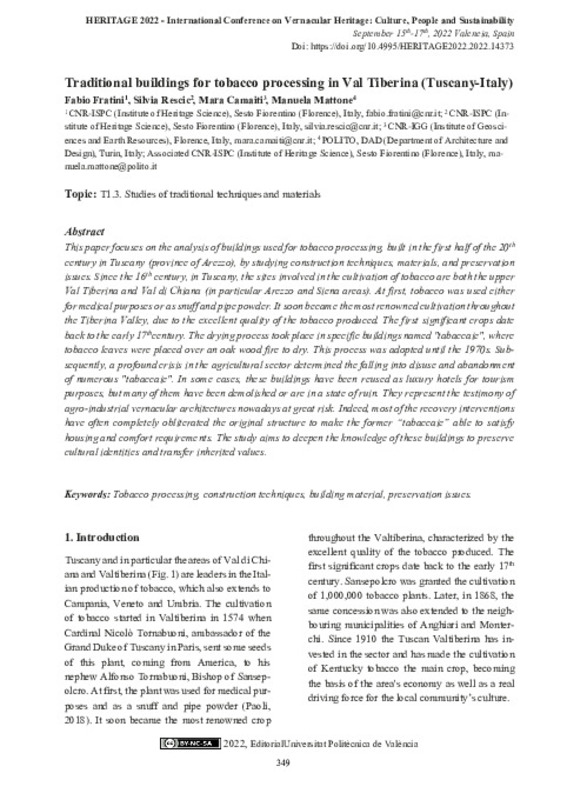JavaScript is disabled for your browser. Some features of this site may not work without it.
Buscar en RiuNet
Listar
Mi cuenta
Estadísticas
Ayuda RiuNet
Admin. UPV
Traditional buildings for tobacco processing in Val Tiberina (Tuscany-Italy)
Mostrar el registro sencillo del ítem
Ficheros en el ítem
| dc.contributor.author | Fratini, Fabio
|
es_ES |
| dc.contributor.author | Rescic, Silvia
|
es_ES |
| dc.contributor.author | Camaiti, Mara
|
es_ES |
| dc.contributor.author | Mattone, Manuela
|
es_ES |
| dc.coverage.spatial | east=12.1736901; north=43.57114989999999; name=Val Tiberina, Tuscany, Província d'Arezzo, Itàlia | es_ES |
| dc.date.accessioned | 2022-11-03T08:43:24Z | |
| dc.date.available | 2022-11-03T08:43:24Z | |
| dc.date.issued | 2022-09-13 | |
| dc.identifier.isbn | 9788413960203 | |
| dc.identifier.uri | http://hdl.handle.net/10251/189046 | |
| dc.description.abstract | [EN] This paper focuses on the analysis of buildings used for tobacco processing, built in the first half of the 20th century in Tuscany (province of Arezzo), by studying construction techniques, materials, and preservation issues. Since the 16th century, in Tuscany, the sites involved in the cultivation of tobacco are both the upper Val Tiberina and Val di Chiana (in particular Arezzo and Siena areas). At first, tobacco was used either for medical purposes or as snuff and pipe powder. It soon became the most renowned cultivation throughout the Tiberina Valley, due to the excellent quality of the tobacco produced. The first significant crops date back to the early 17thcentury. The drying process took place in specific buildings named "tabaccaie", where tobacco leaves were placed over an oak wood fire to dry. This process was adopted until the 1970s. Subsequently, a profound crisis in the agricultural sector determined the falling into disuse and abandonment of numerous "tabaccaie". In some cases, these buildings have been reused as luxury hotels for tourism purposes, but many of them have been demolished or are in a state of ruin. They represent the testimony of agro-industrial vernacular architectures nowadays at great risk. Indeed, most of the recovery interventions have often completely obliterated the original structure to make the former “tabaccaie” able to satisfy housing and comfort requirements. The study aims to deepen the knowledge of these buildings to preserve cultural identities and transfer inherited values. | es_ES |
| dc.format.extent | 8 | es_ES |
| dc.language | Inglés | es_ES |
| dc.publisher | Editorial Universitat Politècnica de València | es_ES |
| dc.relation.ispartof | Proceedings HERITAGE 2022 - International Conference on Vernacular Heritage: Culture, People and Sustainability | |
| dc.rights | Reconocimiento - No comercial - Compartir igual (by-nc-sa) | es_ES |
| dc.subject | Tobacco processing | es_ES |
| dc.subject | Construction techniques | es_ES |
| dc.subject | Building material | es_ES |
| dc.subject | Preservation issues | es_ES |
| dc.title | Traditional buildings for tobacco processing in Val Tiberina (Tuscany-Italy) | es_ES |
| dc.type | Capítulo de libro | es_ES |
| dc.type | Comunicación en congreso | es_ES |
| dc.identifier.doi | 10.4995/HERITAGE2022.2022.14373 | |
| dc.rights.accessRights | Abierto | es_ES |
| dc.description.bibliographicCitation | Fratini, F.; Rescic, S.; Camaiti, M.; Mattone, M. (2022). Traditional buildings for tobacco processing in Val Tiberina (Tuscany-Italy). En Proceedings HERITAGE 2022 - International Conference on Vernacular Heritage: Culture, People and Sustainability. Editorial Universitat Politècnica de València. 349-356. https://doi.org/10.4995/HERITAGE2022.2022.14373 | es_ES |
| dc.description.accrualMethod | OCS | es_ES |
| dc.relation.conferencename | HERITAGE2022 International Conference on Vernacular Heritage: Culture, People and Sustainability | es_ES |
| dc.relation.conferencedate | Septiembre 15-17, 2022 | es_ES |
| dc.relation.conferenceplace | Valencia, España | es_ES |
| dc.relation.publisherversion | http://ocs.editorial.upv.es/index.php/HERITAGE/HERITAGE2022/paper/view/14373 | es_ES |
| dc.description.upvformatpinicio | 349 | es_ES |
| dc.description.upvformatpfin | 356 | es_ES |
| dc.type.version | info:eu-repo/semantics/publishedVersion | es_ES |
| dc.relation.pasarela | OCS\14373 | es_ES |








